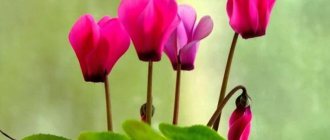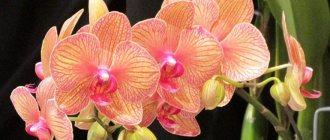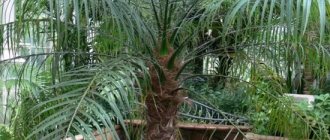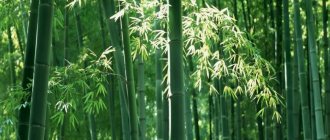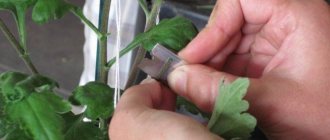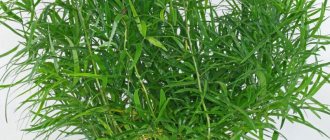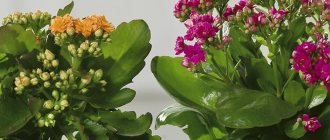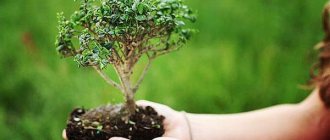The homeland of arrowroot is South America. This is a perennial herbaceous plant. Lovers of indoor flowers appreciate it for the unusual color of the leaf plate. It can be any shade of green.
The leaf has an oval shape, decorated with veins and spots of contrasting color. Arrowroot is a flowering plant; its flower forms a small spikelet.
Arrowroot tricolor
It is distinguished by red veins on the leaf blade. The color of the leaves also contains green and yellow. The reverse side of the sheet is painted crimson.
Varietal diversity
When growing at home, they often use:
- The most popular three-colored species has a contrast of central and lateral reddish veins on a leaflet resembling a fish ridge in appearance, and a crimson underside.
- A two-color type with a striped top and a pubescent bottom with wavy leaves at the edges.
- Reed giantess over 100 cm in size with pointed foliage with fluff.
- Kerkhovena or “Rabbit's Foot” is a low-growing perennial with leaf spots that look like eyes and feathers; at the bottom the red color turns into blue.
- Miniature Massanja with brownish-olive spots.
- A white-veined subspecies with white veins.
Morantha flowers - white, cream, lilac inflorescences in the form of a spike cannot be called spectacular; they are usually removed, preserving the maternal powers and not using the seeds to obtain new samples.
Light
The arrowroot plant loves light, but direct sunlight can be harmful to it. If there is too much light, the color of arrowroot leaves may lose its brightness and richness.
If there is not enough light, the leaves will be small and inconspicuous. Experienced gardeners recommend placing the pot with the plant on the western or eastern side, where there is diffused sunlight.
If there is enough lighting, then its leaves will be located horizontally, and in low light they will begin to stretch vertically.
Diseases and pests
In most cases, “praying grass” does not cause any trouble for its owner: it is quite resistant to infection by infectious diseases. However, it is better for every gardener to have an idea of possible problems, so that if a misfortune occurs, he can quickly localize it.
| Symptoms | Causes |
| The tips of arrowroot leaves turn brown |
|
| The leaves are falling |
|
| Arrowroot leaves are drying |
|
| Loss of decorative color |
|
| Stems become limp and dry out |
|
| Arrowroot leaves become covered with dark spots |
|
If arrowroot leaves become pale, the reason lies in excess sunlight.
It is necessary to move the plant to a more shaded place. The plates may turn yellow when the soil becomes alkalized. To eliminate the problem, water the substrate with slightly acidified water. Root rotting occurs when too dense heavy soil is used during replanting. Young leaf blades dry out due to uneven watering or parasites settling on the arrowroot. In general, many problems (slowing growth, deformation of above-ground parts, loss of decorativeness) can be caused by insects. Most often, “praying grass” is attacked by mealybugs, scale insects, spider mites, and thrips. If not properly cared for, sciarids settle on the soil surface.
Moisture
Arrowroot loves moisture, but it is better not to water it abundantly, but to spray it frequently, at least twice a day. The soil should be slightly moist; in winter, even dry soil is allowed.
It is recommended to use purified warm water when watering to avoid limescale deposits on the leaves. You can also place the plant next to the aquarium to maintain the required humidity.
general information
Arrowroot is an ornamental herbaceous perennial from the family of the same name. Different species differ significantly in appearance and size. Indoor arrowroot most often grows up to 30 cm, but in the wild its growth reaches 1.5 m.
The large patterned leaves of arrowroot are especially prized. Most often they are oval, with protruding veins, colored spots or strokes. In the evening, she raises the leaves up, and during the day they are oriented towards the sun. For this feature, arrowroot is called prayer.
Arrowroot is a tuberous plant, and the tubers of some species are edible. Sometimes it blooms in summer, but its flowering has no decorative value at all. The buds are small, pale and completely inconspicuous, so they are often cut off so that the flower does not waste energy.
Photo: zen.yandex.ru
Top dressing
To strengthen and grow well, it is necessary to water the arrowroot, adding mineral and organic substances to the water. In summer this is done twice a month, in winter once is enough.
Considering that arrowroot comes from the tropics, it is recommended to create an appropriate climate at home for comfortable growing conditions for this beautiful plant. If these requirements are met, the plant will always have bright and lush foliage.
Useful qualities
Arrowroot flour is made from the tubers of the plant. This dietary product treats anemia and anorexia. It contains no proteins and fats, but is high in fiber and ash. The composition also includes folic acid, vitamins PP and B9, calcium. The product has a general strengthening effect, promoting:
- removing toxins from the body;
- lowering blood sugar;
- normalization of sleep;
- improving brain activity.
This natural thickener is an analogue of corn and potato starch and should definitely be included in the family diet. Contraindications for use include individual intolerance, stomach ulcers, and surgical interventions.
Maranta's photos demonstrate her stunning decorativeness, enlivening any interior with its beauty. In addition, there is an opinion that it suppresses negative energy, preventing quarrels and conflict situations in the family.
A non-trivial flower, the sign of Aquarius is the choice of creative, active people. It is a symbol of prosperity, and its flourishing promises monetary profit. In England, a pot with an outlandish bush is a mandatory attribute of virtually every home, called the “10 Commandments.”
Transfer
Arrowroot is usually planted in plastic pots, since ceramic ones contribute to hypothermia of the tubers in winter. The pot itself should be wide enough. It is necessary to place drainage at the bottom, then use loose soil mixed with sand or peat.
It is recommended to do the first transplant after three years. Subsequently, the young plant is replanted in the spring every year, and then, if necessary, the flower pot is replaced with a more spacious one. But at least once every four years.
- Advantages of Gardena gardening equipment
Bathhouse made of 6x6 timber
- Ktenanta - types, cultivation characteristics and instructions for care at home. 110 photos of plants
Home care
The secret to successfully caring for arrowroot is maintaining the temperature and humidity conditions.
The ideal soil for constant growth is a mix of leaf, humus and coniferous soil mixed with sand and charcoal. But standard fibrous peat will not work. Also avoid the presence of lime. Provide high drainage at the bottom.
Temperature
The plant does not tolerate heat and heat above +28...+30C. Avoid direct sunlight, drafts, and sudden temperature changes. Optimal in winter – up to +20C. In winter, it is undesirable to lower it below +14C. At this time of year it is important to keep the leaves away from the cold window.
Fertilizer
During active growth, use complex fertilizers. Specialized solutions for decorative deciduous varieties are now sold. But don’t overuse it, because it’s equally important not to overfeed the arrowroot.
Watering
It is recommended to repeat abundant watering only as the top layer of the substrate dries. During cold weather, reduce the frequency to avoid rotting of the rhizome. For irrigation, use filtered water, or at least soft, settled water. Arrowroot is sensitive to any foreign impurities.
Humidity
Ideal air humidity is about 70%. It can be compensated for by systematically spraying the leaves. This is especially important in summer and during the heating season. A tray with water will help to increase the humidity locally, but in this case, make sure that the moisture does not get on the roots.
Arrowroot feels most comfortable in partial shade. In direct sunlight and bright lighting it fades. In the apartment, pay attention to the windows that face northwest or east.
Reproduction
There are two types of arrowroot propagation:
- Separation when transplanting tubers.
In this case, a tuber with roots and several leaves is selected. Place in a prepared pot with moistened soil and cover with film for several days to maintain the required humidity.
- Cuttings.
At the beginning of summer, a small cutting with two to three leaves is cut from the tops of the shoots and placed in a container with water. Once the roots appear, it will be possible to plant them in a separate pot. In addition, pruning elongated shoots allows you to form the desired shape of the plant and also promotes the appearance of new leaves.
Apical cuttings
Rooted cuttings of the plant can be used for propagation. If the flower produces many long shoots, then they are cut so that they are at least 10 cm long, as well as several leaves with a node in the lower area. After this, they are planted in moist soil, which consists of equal amounts of sand and peat. The cuttings are covered with plastic wrap or glass jars, and then sent to a warm room. To do this, you can use mini-greenhouses where there will be high air humidity.
In addition, the cuttings can be placed in water, where a growth stimulator and activated carbon are added. As a rule, within a month and a half the cuttings will form roots. When their length is about 2.5 cm, the young plants are transplanted into the substrate; they should be provided with shelter and placed in a warm place.
Varieties
Tricolor (tricolor). This is a plant with dark green leaves edged with a paler color. There are light green streaks running down the center. The dark red veins become darker towards the edges. Tricolor arrowroot is the most unpretentious and widespread type of this plant.
Bush 30 cm high. Leaf blades are pubescent, about 12 cm long. The background of the outer side is dark or light green. It has light green spots and red veins. The reverse side is crimson with pink veins. The flowers of the plant are light lilac.
White veined (Fascinator). The leaves are oval, reaching a length of 15 cm. Features: on the dark green leaves there is a silver stripe running down the center. Along with the tricolor, it is unpretentious.
In nature it grows mainly in the tropics of Brazil. The bush is about 30 cm high, with a tuberous root. The leaves reach no more than 15 cm in length. The front surface is dark green, with white veins visible on it. The underside is pale red or blue-green.
One of the most popular varieties is Kerkhoven's arrowroot. It has a height of up to 25 cm, short petioles, on which oval leaves are placed 15 cm in length. The upper part is bright green, with dark green spots and white veins visible on it. The inner side is red, turning into a bluish tint.
Arrowroot two-color. Quite a rare species with dark green leaves, on which light specks are scattered. It differs from others in the absence of tubers. The leaves are 15 cm long, with a wavy border, located on short petioles. The background of the leaves is green, with brown spots on it. There are hairs on the reverse side, the color is pale red.
Reed arrowroot. This plant can reach a height of 1 m. The leaves are oval, elongated, and have a gray tint. Stems are erect and powerful. The root system is tuberous.
The leaf blades are ovate, up to 25 cm long, with pointed tips. The background is dark gray with green stripes. The reverse side is dark green.
Proper watering
Maranta prefers moderation in watering. Naturally, during the hot period, its growth is activated and watering should be slightly increased, but the main thing is not to overwater, keep the soil moist.
But during the dormant period, watering is reduced, but do not allow the soil in the pot to dry out. Water the plant with soft water at room temperature.
